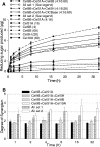Characterization and synergistic interactions of Fibrobacter succinogenes glycoside hydrolases
- PMID: 17660301
- PMCID: PMC2075001
- DOI: 10.1128/AEM.01037-07
Characterization and synergistic interactions of Fibrobacter succinogenes glycoside hydrolases
Abstract
The objectives of this study were to characterize Fibrobacter succinogenes glycoside hydrolases from different glycoside hydrolase families and to study their synergistic interactions. The gene encoding a major endoglucanase (endoglucanase 1) of F. succinogenes S85 was identified as cel9B from the genome sequence by reference to internal amino acid sequences of the purified native enzyme. Cel9B and two other glucanases from different families, Cel5H and Cel8B, were cloned and overexpressed, and the proteins were purified and characterized. These proteins in conjunction with two predominant cellulases, Cel10A, a chloride-stimulated cellobiosidase, and Cel51A, formerly known as endoglucanase 2 (or CelF), were assayed in various combinations to assess their synergistic interactions using ball-milled cellulose. The degree of synergism ranged from 0.6 to 3.7. The two predominant endoglucanases produced by F. succinogenes, Cel9B and Cel51A, were shown to have a synergistic effect of up to 1.67. Cel10A showed little synergy in combination with Cel9B and Cel51A. Mixtures containing all the enzymes gave a higher degree of synergism than those containing two or three enzymes, which reflected the complementarity in their modes of action as well as substrate specificities.
Figures




References
-
- Bera, C., V. Broussolle, E. Forano, and G. Gaudet. 1996. Gene sequence analysis and properties of EGC, a family E (9) endoglucanase from Fibrobacter succinogenes BL2. FEMS Microbiol. Lett. 136:79-84. - PubMed
-
- Bera-Maillet, C., V. Broussolle, P. Pristas, J. P. Girardeau, G. Gaudet, and E. Forano. 2000. Characterisation of endoglucanases EGB and EGC from Fibrobacter succinogenes. Biochim. Biophys. Acta 1476:191-202. - PubMed
-
- Blackwell, J. R., and R. Horgan. 1991. A novel strategy for production of a highly expressed recombinant protein in an active form. FEBS Lett. 295:10-12. - PubMed
Publication types
MeSH terms
Substances
Associated data
- Actions
- Actions
- Actions
LinkOut - more resources
Full Text Sources
Other Literature Sources
Molecular Biology Databases

